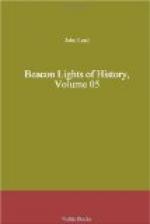LIST OF ILLUSTRATIONS
Volume V.
Roland Calls for Succor in the Battle of Roncesvalles
After the painting by Louis Guesnet.
A Reading from the Koran
After the painting by W. Gentz.
Mohammed, Preaching the Unity of God, Enters the City of Mecca After the painting by A. Mueller.
Charlemagne Inflicts the Rite of Baptism on the Saxons
After the painting by Adolph Maria Mucha.
St. Bernard Counselling Conrad III.
After the painting by Adolph Maria Mucha.
Canterbury Cathedral
From a photograph.
St. Thomas Aquinas in the School of Albertus Magnus
After the painting by H. Lerolle.
Murder of St. Thomas a Becket
After the painting by A. Dawant.
The Accolade
After the painting by Sir E. Blair Leighton.
Winchester Cathedral
From a photograph.
Facsimile of Page from Wyclif Bible
BEACON LIGHTS OF HISTORY
* * * * *
Mohammed.[1]
* * * * *
A.D. 570-632.
Saracenic conquests.
[Footnote 1: Spelled also Mahomet, Mahommed; but I prefer Mohammed.]
The most extraordinary man who arose after the fall of the Roman Empire was doubtless Mohammed; and his posthumous influence has been greater than that of any man since Christianity was declared, if we take into account the number of those who have received his doctrines. Even Christianity never had so rapid a spread. More than a sixth part of the human race are the professed followers of the Arabian prophet.
In regard to Mohammed himself, a great change has taken place in the opinions of critics within fifty years. It was the fashion half a century ago to speak of this man as a hypocrite, an impostor, even as Antichrist. Now he is generally regarded as a reformer; that is, as a man who introduced into Arabia a religion and a morality superior to what previously existed, and he is regarded as an impostor only so far as he was visionary. Few critics doubt his sincerity. He was no hypocrite, since he himself believed in his mission; and his mission was benevolent,—to turn his countrymen from a gross polytheism to the worship of one God. Although his religion cannot compare with Christianity in purity and loftiness, yet it enforced a higher morality than the old Arabian religions, and assimilated to Christianity in many important respects. The chief fault we have to find in Mohammed was, the propagation of his doctrines by the sword, and the use of wicked means to bring about a good end. The truths he declared have had an immense influence on Asiatic nations, and these have given vitality to his system, if we accept the position that truth alone has vitality.




